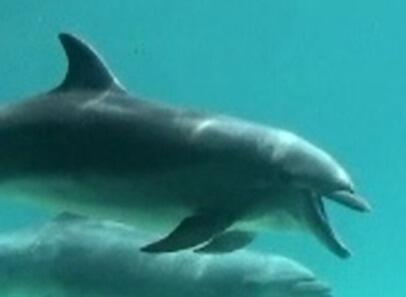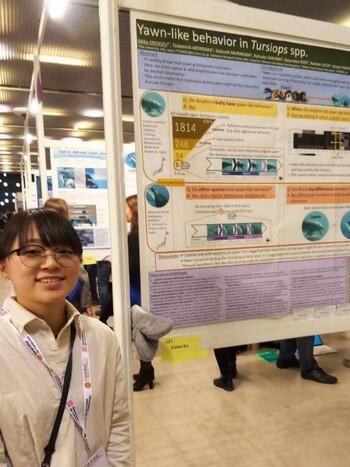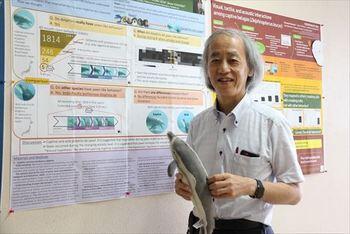Summary of our research
Ms. ENOKIZU Akiko(3rd grade of Doctoral Course at Graduate School of Bioresources, Mie University) found yawning in captive common bottlenose dolphins in a collaborative study with Minamichita Beachland Aquarium under the supervisions of Assoc. Prof. MORISAKA Tadamichi and Prof. YOSHIOKA Motoi. This is the first-ever report of yawning in a fully-aquatic mammal, expanding the current established yawning definition.
We humans naturally yawn when we feel sleepy. Yawning is observed in a variety of vertebrates, and it is defined as follows: "A yawn begins with a slow opening of the mouth with inhalation, followed by a maximum gaping phase, and ends with a short exhalation and the closing of the mouth." Ms. ENOKIZU observed the behaviors of the captive common bottlenose dolphins at Minamichita Beachland for a long time (119 hours in total), and found the five cases of yawn-like behaviors, where dolphins opened their mouth slowly, kept maximum gape for a while, and closed their mouth quickly (Fig 1). They concluded that these yawn-like behaviors were real yawning in common bottlenose dolphins because the behaviors occurred during inactive phase, and so on.
This study suggested that yawning does not need breathing because dolphins yawn without breath underwater. It means that we need to change the definition of yawning in animals. Although this study is the first-ever report of yawning in aquatic mammals, it is plausive to discard "breathing" from the definition of yawning because there are some reports that human fetuses also yawn in amniotic fluid. Yawning, which we do without paying much attention to, is scientifically a very interesting behavior which there is still so much to discover.

Figure 1. Yawning in a captive bottlenose dolphin @ Minamichita Beachland
The study was published online in the scientific journal "Behavioural Processes" on 12th June, 2021.
Yawn-like behavior in captive common bottlenose dolphins (Tursiops truncatus)
https://doi.org/10.1016/j.beproc.2021.104444
This study was supported by the Collaborative Research Program of the Wildlife Research Center, Kyoto University (2018-A-41) and JSPS KAKENHI (Grant Number 15H05709).
Researcher information

ENOKIZU Akiko
3rd grade of Doctoral Course at Graduate School of Bioresources
Specialized area:
Ethology (Animal Behavior)
Current research field:
・ Yawning in aquatic mammals
・ Evolution of yawning in mammals

MORISAKA Tadamichi, Ph.D.
Associate Professor, Cetacean Research Center, Graduate School of Bioresources
Specialized area:
Bioacoustics, Ethology, Cetology
Current research field:
・ Description of interesting behaviors in cetaceans
・ Development of the elementary techniques for cetacean conservation
・ Basic study for cetacean communication and society

YOSHIOKA Motoi, Ph.D.
Professor of Graduate School of Bioresources
Specialized area:
Marine mammalogy, Reproductive physiology
Current research field:
・ Understanding of the mechanism of cetacean reproductive physiology
・ Understanding of the life history of narrow-ridged finless porpoises in Ise Bay.